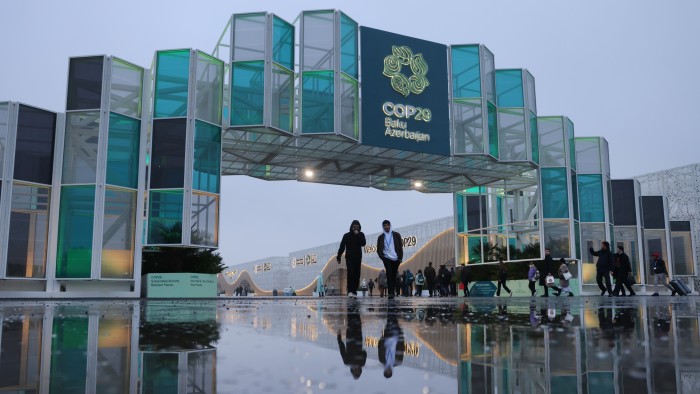Big Tech has lowered its profile at the UN COP29 climate summit this year, as industry concerns rise about the sector being targeted as the “new oil and gas” as a result of the power demands of data centres to support artificial intelligence.
In contrast to previous UN climate summits in Dubai and Sharm el-Sheikh, tech leaders such as Google, Microsoft and Amazon have been less visible in Baku. “We don’t have anything there this year,” a Meta spokesperson said.
While tech groups place store in AI for its potential to cut greenhouse gases, as it helps to develop more efficient systems, the spike in energy use has put focus on the rising contribution to global warming in the meantime.
“If our industry starts getting treated similar to oil and gas, the public relations to counter that are going to be very expensive,” said Kevin Thompson, chief operating officer at Gesi, a business group focused on digital sustainability which is represented at COP29.
Google reported earlier this year that its energy emissions had jumped by almost half in the past five years because of the needs of AI.
Global emissions from data centres would almost triple by the end of the decade because of the buildout in generative AI, compared with a scenario in which this technology was not used, a recent Morgan Stanley analysis forecast.
It said data centres could contribute to 5.1 per cent of global emissions by the end of the decade versus 1.9 per cent this year, both relative to 2022 global emissions.
But Adam Elman, Google’s director of sustainability in Europe, the Middle East and Africa, pointed to 2022 International Energy Agency data showing it accounted for 1.3 per cent of total electricity consumption which he said put the climate impact “into perspective”. The IEA also predicted the sector’s electricity demand would see “rapid” growth, however.
“The Googles, Amazons, Microsofts are the big investors in clean energy,” Elman added. The sector has been keen to step up its direct investments in clean energy in the past five years, including most recently nuclear energy.
While still sending representatives to Baku, the big tech companies largely chose not to exhibit publicly in the conference’s business area, known as the green zone.
In the absence of Silicon Valley’s leading lights among pavilions displaying corporate efforts, it was left to Azersun, a local conglomerate. It showed a machine-learning tool that the food and agriculture-based group said could give business and people advice on cutting their carbon footprint. It also ran AI-generated films about climate change.
“We are kind of the talk of the town, or the talk of the COP,” said Zeynep Yildiz, a marketing manager at the stand.

One energy consultant said the reduced tech presence at COP29 was in line with the fall in the representation of the business community generally. “I think they don’t see big business in [the] central Asia region,” they said.
The climate summit for the first time featured a “Digitalisation Day” to promote “green digital action”. But the associated events focused more on extreme weather prediction than on how it could help with cutting emissions.
In the official “blue zone” area open only to parties to the conference, Microsoft was one of 30 corporate and philanthropic co-sponsors of the UN climate change pavilion, alongside organisations as diverse as 3M and The Children’s Investment Fund Foundation. It also contributed to a panel discussion about its role in UN initiatives on emissions reporting and early warning systems.
Amazon teams also held discussions at COP29 with policymakers and with companies that have signed up to its Amazon Climate Pledge, which encourages corporates to make promises, including on clean energy, decarbonising maritime trade and the use of AI.
An AI-generated PowerPoint presentation by Bulgaria, which has become a hub for corporate tech support and software engineers, highlighted the climate-predicting capabilities of its “petascale supercomputer”.
Petascale computing refers to systems capable of performing at least a quadrillion calculations each second — though the demonstration suffered initial glitches before loading.
The tech industry is still grappling with fundamental accounting issues that will define how it is perceived in relation to climate change, experts say. This includes the question of which party should be responsible for the CO₂ emissions produced when fossil fuels are burnt for power or cooling.
There was a need for clarity on whether the data centre owner, operator or ultimate client should be held accountable, said Mary de Wysocki, Cisco’s chief sustainability officer.
A global standard-setting body for voluntary rules on carbon accounting, known as the Greenhouse Gas Protocol, is not expected to finalise new guidance for counting emissions from power use until next year.
This will include ruling on whether the carbon footprint from energy used in one country could be offset by the purchase of certificates which loosely represent investments in wind or solar energy generated elsewhere in the world.
Mark Campanale, founder of the non-profit Carbon Tracker think-tank, said the “extraordinary explosion in interest in AI and growth in power demand for cloud computing and data storage” posed a short-term challenge.
It would take a few years for their investments into wind, solar and battery storage projects to “wash through” permitting systems and translate into enough clean energy to keep ahead of the rise in energy demand, he said.
“They [tech companies] know they need to sort it but they’re not letting concern about climate risk get in the way of delivering customers what they want, that’s the brute reality.”
Climate Capital

Where climate change meets business, markets and politics. Explore the FT’s coverage here.
Are you curious about the FT’s environmental sustainability commitments? Find out more about our science-based targets here


